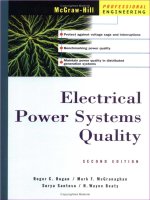C567 00
Bạn đang xem bản rút gọn của tài liệu. Xem và tải ngay bản đầy đủ của tài liệu tại đây (19.96 KB, 3 trang )
Designation: C 567 – 00
Standard Test Method for
Determining Density of Structural Lightweight Concrete1
This standard is issued under the fixed designation C 567; the number immediately following the designation indicates the year of
original adoption or, in the case of revision, the year of last revision. A number in parentheses indicates the year of last reapproval. A
superscript epsilon (e) indicates an editorial change since the last revision or reapproval.
This standard has been approved for use by agencies of the Department of Defense.
8.2 reached by structural lightweight concrete after exposure to
relative humidity of 50 6 5 % and a temperature of 23 6 2°C
(73.5 6 3.5°F) for a period of time sufficient to reach constant
mass.
3.2.2 oven-dry density—the density as determined in 8.3
reached by structural lightweight concrete after being placed in
a drying oven at 110 6 5°C (230 6 9°F) for a period of time
sufficient to reach constant mass.
1. Scope
1.1 This test method provides procedures to determine the
oven-dry and equilibrium densities of structural lightweight
concrete.
1.2 The values stated in SI units are to be regarded as the
standard. The values given in parentheses are for information
only.
1.3 This standard does not purport to address all of the
safety concerns, if any, associated with its use. It is the
responsibility of the user of this standard to establish appropriate safety and health practices and determine the applicability of regulatory limitations prior to use.
4. Summary of Test Method
4.1 This test method provides procedures for determining
the oven-dry and equilibrium densities of structural lightweight
concrete, by calculation or measurement. The calculated ovendry density is determined from batch quantities and volume of
a given batch of concrete. The calculated equilibrium density is
approximated by adding a fixed quantity to the oven-dry
density. Measured densities are obtained from determinations
of the mass of cylindrical specimens after specified treatments.
2. Referenced Documents
2.1 ASTM Standards:
C 31/C 31M Practice for Making and Curing Concrete Test
Specimens in the Field2
C 88 Test Method for Soundness of Aggregates by Use of
Sodium Sulfate or Magnesium Sulfate2
C 125 Terminology Relating to Concrete and Concrete
Aggregates2
C 138 Test Method for Unit Weight, Yield, and Air Content
(Gravimetric) of Concrete2
C 172 Practice for Sampling Freshly Mixed Concrete2
C 192/C 192M Practice for Making and Curing Concrete
Test Specimens in the Laboratory2
C 470/C 470M Specification for Molds for Forming Concrete Test Cylinders Vertically2
E 104 Practice for Maintaining Constant Relative Humidity
by Means of Aqueous Solutions3
5. Significance and Use
5.1 The measured or calculated equilibrium density of
structural lightweight concrete determines whether specified
density requirements have been met. Unless otherwise specified, determine equilibrium density by calculation using the
procedures in 9.2.
5.2 Test Method C 138 shall be used to determine the
density of freshly mixed lightweight concrete for compliance
with concrete placement specifications.
NOTE 1—The fresh density of lightweight aggregate concrete is a
function of mixture proportions, air content, water demand, and the
specific density and moisture content of the lightweight aggregate.
Decrease in density of a specific lightweight concrete is due to moisture
loss that, in turn, is a function of aggregate moisture content, ambient
conditions, and the ratio of the surface area to the volume of the concrete
member. For most structural lightweight concretes, equilibrium density is
approached at about 90 days. For most high-strength lightweight concretes, equilibrium density is approached at about 180 days. Extensive
tests demonstrate that despite variations in the initial moisture content of
lightweight
aggregate, the equilibrium density will be approximately 50
3
kg/m (3.0 lb/ft3) greater than the oven-dry density.
3. Terminology
3.1 Terminology used in this test method is defined in
Terminology C 125.
3.2 Definitions of Terms Specific to This Standard:
3.2.1 equilibrium density, n—the density as determined in
1
This test method is under the jurisdiction of ASTM Committee C09 on
Concrete and Concrete Aggregates and is the direct responsibility of Subcommittee
C09.21 on Lightweight Aggregates and Concrete.
Current edition approved July 10, 2000. Published September 2000. Originally
published as C 567 – 65 T. Last previous edition C 567 – 99a.
2
Annual Book of ASTM Standards, Vol 04.02.
3
Annual Book of ASTM Standards, Vol 11.03.
6. Apparatus
6.1 Tamping Rod, Mallet, Measure, Balance, and Molds—
These shall conform to the requirements of Test Method C 138
Copyright © ASTM, 100 Barr Harbor Drive, West Conshohocken, PA 19428-2959, United States.
1
C 567
and Specification C 470.
6.1.1 Measure—A 14-L (0.5-ft3) measure shall be the standard (see Note 3).
6.2 Controlled Humidity Enclosure—A room controlled at
50 6 5 % relative humidity and 23 6 2°C (73.5 6 3°F) or a
small chamber meeting the requirements of Practice E 104.
6.3 Drying Oven—An oven of appropriate size capable of
maintaining a uniform temperature of 1106 5°C (230 6 9°F),
and an average evaporation rate of at least 25 g/h. Determine
evaporation rate in accordance with Test Method C 88.
cylinder. Dry the cylinders with all surfaces exposed, in a
controlled humidity enclosure as described in 6.2 until the
mass of the specimen changes not more than 0.5 % (gain or
loss) in successive determinations of mass 28 days apart.
Determine the mass of the dried cylinders and record as “A,”
the mass of the dried cylinder. Calculate the equilibrium
density of the concrete from Eq 1 and 2.
7. Sampling, and Making, and Curing Test Specimens
7.1 Sampling—Sample field-mixed concrete in accordance
with Practice C 172.
7.2 Specimens for Determining Equilibrium Density and
Oven-dry Density—Determine the equilibrium density and
oven-dry density on 150 by 300-mm (6 by 12-in.) concrete
cylinders.
7.2.1 Make test cylinders in accordance with Practice
C 192/C 192M or C 31/C 31M, whichever is applicable. Make
three cylinders for equilibrium density measurements, and
make three cylinders for oven-dry density measurements.
7.3 Curing Specimens:
7.3.1 Unless otherwise specified, test cylinders used for the
determination of equilibrium density shall be cured in accordance with Practice C 192/C 192M or the standard curing
procedure in Practice C 31/C 31M for six days.
where:
Em =
A =
B =
C =
Em ~Density, kg/m3! 5 ~A 3 997! / ~B2C!
3
Em ~Density, lb/ft ! 5 ~A 3 62.3! / ~B2C!!
(1)
(2)
measured equilibrium density, kg/m3(lb/ft3,
mass of cylinder as dried, kg (lb),
mass of saturated surface-dry cylinder, kg (lb), and
apparent mass of suspended-immersed cylinder, kg
(lb).
8.3 Measurement of Oven-Dry Density—After 24 h but not
to exceed 32 h, remove the cylinders from the mold (see Note
4). Measure the apparent mass of the cylinders while suspended and completely submerged in water and record as “G”
the mass of the suspended-immersed cylinders. Remove from
the water and allow to drain for 1 min by placing the cylinders
on a 9.5-mm (3⁄8-in.) or coarser sieve cloth. Remove visible
water with a damp cloth, determine the mass and record as “F,”
the mass of the saturated surface-dry cylinders. Place the
cylinders in the drying oven for 72 h or until constant mass is
reached. Maintain oven temperature at 110 6 5°C (230 6 9°F).
Allow cylinders to cool to room temperature and determine the
mass and record as “D,” the mass of the oven-dried cylinder.
Repeat oven-drying and determination of mass at 24-h intervals until the mass of the specimen changes not more than
0.5 % in successive weighings 24 h apart. Determine the
oven-dry density from Eq 3 and 4.
NOTE 2—Cylinders may be stripped after 24 h and wrapped securely
with a plastic sheet or bag to prevent loss of moisture, or may remain in
covered molds until the time of test.
7.3.2 Unless otherwise specified, for the first 24 h or until
the time of test, store the test cylinders used for the determination of oven-dry density under conditions that maintain a
temperature adjacent to the cylinders in the range from 16 to
27°C (60 to 80°F) and that prevent loss of moisture from the
cylinders.
Om ~Density, kg/m3!5 ~D 3 997! / ~F2G!
3
Om ~Density, lb/ft !5 ~D 3 62.3! / ~F2G!!
8. Procedure
8.1 Measurement of Freshly Mixed Concrete Density—
Determine the density of the freshly mixed concrete in accordance with Test Method C 138.
where:
Om =
D =
F
=
G =
NOTE 3—Numerous observations indicate that the same compactive
effort used on smaller concrete specimens will cause the fresh densities to
be higher. The fresh density as determined from measurements on 150 by
300-mm (6 by 12-in.) cylinders of lightweight concrete consolidated by
rodding, in accordance with Practice C 192/C 192M or Practice C 31/
C 31M will average 40 kg/m3 (2.5 lb/ft3) higher than the fresh density as
measured using a 14-L (0.5-ft3) measure in accordance with Test Method
C 138.
(3)
(4)
measured oven-dry density, kg/m3(lb/ft3),
mass of oven-dry cylinder, kg (lb),
mass of saturated surface-dry cylinder, kg (lb), and
apparent mass of suspended-immersed cylinder, kg
(lb).
NOTE 4—Determination of oven-dry density may be specified to begin
at an age other than 24-h.
9. Calculation
9.1 Calculation of Oven-Dry Density—Where mixture
quantities, aggregate moisture content, and the volume of the
concrete batch are known, calculate an oven-dry density using
Eq 5.
8.2 Measurement of Equilibrium Density—To measure the
equilibrium density, remove the cylinders from their curing
condition on the sixth day and immerse in water at 23 6 2°C
(73.5 6 3°F) for 24 h. Measure the apparent mass of the
cylinders while suspended and completely submerged in water
and record as “C,” the mass of the suspended-immersed
cylinder. Remove from the water and allow to drain for 1 min
by placing the cylinder on a 9.5-mm (3⁄8-in.) or coarser sieve
cloth. Remove visible water with a damp cloth, determine the
mass and record as “B,” the mass of the saturated-surface-dry
Oc 5 ~Mdf 1 Mdc 1 1.2 Mct! / V
where:
Oc =
Mdf =
Mdc =
Mct =
2
calculated oven-dry density, kg/m3 (lb/ft3),
mass of dry fine aggregate in batch, kg(lb),
mass of dry coarse aggregate in batch, kg(lb),
mass of cement in batch, kg (lb),
(5)
C 567
10.1.7 Mass of oven-dry cylinder, kg (lb).
10.1.8 Oven-dry density rounded to the nearest 10 kg/m3
(0.5 lb/ft3).
10.2 When oven-dry and approximate equilibrium densities
are determined by calculation, report the following information:
10.2.1 Fresh density, kg/m3 (lb/ft3).
10.2.2 Mass of cement and dry aggregates, batched, kg (lb).
10.2.3 Volume of concrete produced from the batch, m3
3
(ft ).
10.2.4 Calculated oven-dry density, to the nearest 10 kg/m3
(0.5 lb/ft3).
10.2.5 Calculated approximate equilibrium density, to the
nearest 10 kg/m3 (0.5 lb/ft3).
1.2
= factor to approximate the mass of cement plus
chemically combined water, and
V
= volume of concrete produced by the batch m3 (ft3).
9.2 Calculation of Approximate Equilibrium Density—
Using the oven-dry density determined in accordance with 8.3
or 9.1, calculate the approximate equilibrium density from Eq
6 and 7.
Ec 5 Oc 1 50 kg/m3 ~3 lb/ft3!
(6)
Ec 5 Om 1 50 kg/m3 ~3 lb/ft3!
(7)
or
where:
Ec = calculated equilibrium density (see Note 1).
11. Precision and Bias
11.1 Precision—The precision of this test method has not
yet been determined, but an industry-wide multilaboratory
testing program is being coordinated. The precision statements
will be included when the data is compiled and reviewed.
11.2 Bias—Bias for this test method cannot be determined
since there is no reference standard available for comparison.
10. Report
10.1 When oven-dry and equilibrium densities are determined by measurements, the report shall include following
information:
10.1.1 Fresh density, kg/m3 (lb/ft3).
10.1.2 Mass of suspended-immersed cylinder, kg (lb).
10.1.3 Mass of saturated surface dry cylinder, kg (lb).
10.1.4 Mass of cylinder after reaching equilibrium, kg (lb).
10.1.5 Equilibrium density reported to nearest 10 kg/m3 (0.5
lb/ft3).
10.1.6 Age at which equilibrium was reached, days.
12. Keywords
12.1 equilibrium density; lightweight concrete; oven-dry
density
The American Society for Testing and Materials takes no position respecting the validity of any patent rights asserted in connection
with any item mentioned in this standard. Users of this standard are expressly advised that determination of the validity of any such
patent rights, and the risk of infringement of such rights, are entirely their own responsibility.
This standard is subject to revision at any time by the responsible technical committee and must be reviewed every five years and
if not revised, either reapproved or withdrawn. Your comments are invited either for revision of this standard or for additional standards
and should be addressed to ASTM Headquarters. Your comments will receive careful consideration at a meeting of the responsible
technical committee, which you may attend. If you feel that your comments have not received a fair hearing you should make your
views known to the ASTM Committee on Standards, at the address shown below.
This standard is copyrighted by ASTM, 100 Barr Harbor Drive, PO Box C700, West Conshohocken, PA 19428-2959, United States.
Individual reprints (single or multiple copies) of this standard may be obtained by contacting ASTM at the above address or at
610-832-9585 (phone), 610-832-9555 (fax), or (e-mail); or through the ASTM website (www.astm.org).
3









